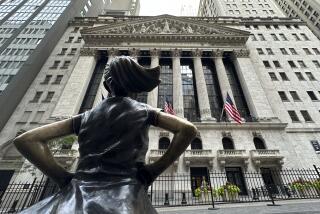Markets Reflect Faith in Earnings Recovery
Investors kept the faith in the first quarter about a corporate earnings recovery this year.
Doubts in late January and early February sent many stocks lower for a while, but trust in the recovery helped spur a strong rally in March.
That left the blue-chip Standard & Poor’s 500 index at 1,147.39 by Thursday, the last day of trading in the quarter (markets were closed on Good Friday). The index’s net price change for the quarter: a slight loss of 0.06%.
Most other major market indexes posted gains for the quarter. The Dow Jones industrial average, at 10,403.94 on Thursday, rose 3.8% in the quarter, after gaining 13.3% in the fourth quarter.
The Wilshire 5,000 index was up 0.6% in the first three months after rising 12% in the fourth quarter. The New York Stock Exchange composite index added 1.8% in the quarter. It gained 8.5% in the previous period.
Indexes of smaller stocks generally performed better than blue-chip indexes in the first quarter, continuing the trend of the last two years, as investors have hunted for bargains among lesser-known names.
The S&P; small-stock index surged 6.8% in the quarter, and the S&P; mid-sized stock index rose 6.5%. The Russell 2,000, another small-stock index, added 3.7%.
The standout loser among major indexes was the technology-dominated Nasdaq composite index, which slumped 5.4% in the quarter, to 1,858.25 by Thursday, after soaring 30% in the fourth quarter.
Many investors are nervous about share prices, fearful that the rebound from the three-year lows reached in the aftermath of the Sept. 11 terrorist attacks has left stocks overvalued--or at least not undervalued--relative to earnings expected this year and in 2003.
In other words, investors believe a profit recovery will happen, but many are concerned that stock prices already reflect that recovery.
Technology stocks have borne the brunt of valuation concerns because price-to-earnings ratios in the tech sector remain among the highest of any industry sector.
The average blue-chip stock is priced at 20 to 25 times estimated 2002 earnings per share, depending on whose earnings estimates are used.
In the tech sector, price-to-earnings ratios are 40 or higher for many leading companies based on 2002 profit estimates that already assume a sharp recovery starting in the second quarter.
Still, the stock market’s ability to hold up as well as it did in the first quarter, considering the Enron Corp. scandal, rising interest rates and higher energy prices, suggests that most investors believe that corporate earnings definitely are poised to rebound this year--and that share prices aren’t excessive based on expected earnings.
More to Read
Inside the business of entertainment
The Wide Shot brings you news, analysis and insights on everything from streaming wars to production — and what it all means for the future.
You may occasionally receive promotional content from the Los Angeles Times.










